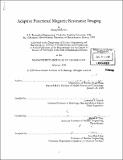| dc.contributor.advisor | Lawrence P. Panych. | en_US |
| dc.contributor.author | Yoo, Seung-Schik | en_US |
| dc.contributor.other | Harvard University--MIT Division of Health Sciences and Technology. | en_US |
| dc.date.accessioned | 2012-05-21T17:27:20Z | |
| dc.date.available | 2012-05-21T17:27:20Z | |
| dc.date.copyright | 2000 | en_US |
| dc.date.issued | 2000 | en_US |
| dc.identifier.uri | http://hdl.handle.net/1721.1/70893 | |
| dc.description | Thesis (Ph.D.)--Massachusetts Institute of Technology, Dept. of Nuclear Engineering, 2000. | en_US |
| dc.description | Some research performed with the Harvard-M.I.T. Division of Health Sciences and Technology. | en_US |
| dc.description | Includes bibliographical references (leaves 132-140). | en_US |
| dc.description.abstract | Functional MRI (fMRI) detects the signal associated with neuronal activation, and has been widely used to map brain functions. Locations of neuronal activation are localized and distributed throughout the brain, however, conventional encoding methods based on k-space acquisition have limited spatial selectivity. To improve it, we propose an adaptive fMRI method using non-Fourier, spatially selective RF encoding. This method follows a strategy of zooming into the locations of activation by progressively eliminating the regions that do not show any apparent activation. In this thesis, the conceptual design and implementation of adaptive fMRI are pursued under the hypothesis that the method may provide a more efficient means to localize functional activities with increased spatial or temporal resolution. The difference between functional detection and mapping is defined, and the multi- resolution approach for functional detection is examined using theoretical models simulating variations in both in-plane and through-plane resolution. We justify the multi-resolution approach experimentally using BOLD CNR as a quantitative measure and compare results to those obtained using theoretical models. We conclude that there is an optimal spatial resolution to obtain maximum detection; when the resolution matches the size of the functional activation. We demonstrated on a conventional 1.5-Tesla system that RF encoding provides a simple means for monitoring irregularly distributed slices throughout the brain without encoding the whole volume. We also show the potential for increased signal-to-noise ratio with Hadamard encoding as well as reduction of the in-flow effect with unique design of excitation pulses. | en_US |
| dc.description.abstract | (cont.) RF encoding was further applied in the implementation of real-time adaptive fMRI method, where we can zoom into the user-defined regions interactively. In order to do so, real-time pulse prescription and data processing capabilities were combined with RF encoding. Our specific implementation consisted of five scan stages tailored to identify the volume of interest, and to increase temporal resolution (from 7.2 to 3.2 seconds) and spatial resolution (from 10 mm to 2.5-mm slice thickness). We successfully demonstrated the principle of the multi- resolution adaptive fMRI method in volunteers performing simple sensorimotor paradigms for simultaneous activation of primary motor as well as cerebellar areas. | en_US |
| dc.description.statementofresponsibility | by Seung-Schik Yoo. | en_US |
| dc.format.extent | 140 leaves | en_US |
| dc.language.iso | eng | en_US |
| dc.publisher | Massachusetts Institute of Technology | en_US |
| dc.rights | M.I.T. theses are protected by
copyright. They may be viewed from this source for any purpose, but
reproduction or distribution in any format is prohibited without written
permission. See provided URL for inquiries about permission. | en_US |
| dc.rights.uri | http://dspace.mit.edu/handle/1721.1/7582 | en_US |
| dc.subject | Nuclear Engineering. | en_US |
| dc.subject | Harvard University--MIT Division of Health Sciences and Technology. | en_US |
| dc.title | Adaptive functional magnetic resonance imaging | en_US |
| dc.title.alternative | Adaptive fMRI | en_US |
| dc.title.alternative | Adaptive functional MRI | en_US |
| dc.type | Thesis | en_US |
| dc.description.degree | Ph.D. | en_US |
| dc.contributor.department | Massachusetts Institute of Technology. Department of Nuclear Engineering | en_US |
| dc.contributor.department | Massachusetts Institute of Technology. Department of Nuclear Science and Engineering | |
| dc.identifier.oclc | 48759378 | en_US |
